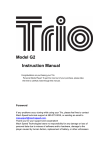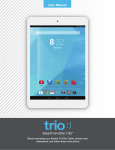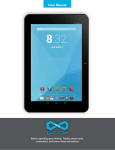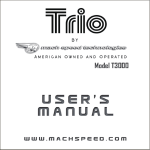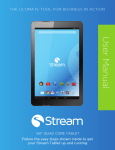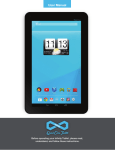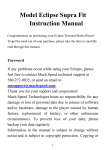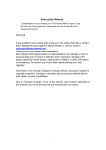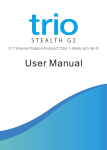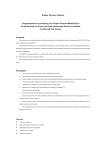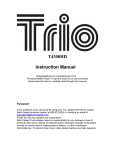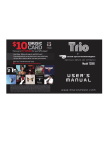Download Mach Speed Technologies V5000 User's Manual
Transcript
Trio V5000 Instruction Manual Congratulations on purchasing your Trio Personal Media Player! To get the most out of your purchase, please take the time to carefully read through this manual. Foreword If any problems occur during while using your Trio, please feel free to contact Mach Speed technical support at 580-272-0035, or sending an email to [email protected]. Thank you for your support and cooperation! Mach Speed Technologies bears no responsibility for any damage or loss of personal data due to misuse of software and/or hardware, damage to the player caused by human factors, replacement of battery, or other unforeseen circumstances. To prevent loss of your data, please backup your data regularly. Information in the manual is subject to any change without notice and is subject to copyright protection. Copying or otherwise reproducing this material without prior written consent is prohibited. Due to Firmware changes, some of the pictures and functions described in this manual may not be the same as are included with your player. 1 Note: ● The playback times listed refer to the maximum playback times possible, using the best power savings. The actual playback time may differ as adjustments to screen brightness, power savings modes, volume, etc are made. ● As there are many brands of Micro SD cards in market, using different quality and speed standards. Therefore, we are unable to guarantee that our product will be compatible with all types or brands of Micro SD cards, but will be compatible with those Micro SD cards with mainstream specifications in the market, and we will constantly strive to provide the largest selection of cards possible. ● As parameters such as formats, bitrate, codecs, framerates, and resolutions differ, the player will not be compatible with all listed files. If you are experiencing issues playing your files on this player, we recommend using a supported conversion tool to reconvert your file to the specifications of the device. Caution Modifications not approved by the party responsible for compliance could void the user’s authority to operate the equipment. NOTE- This equipment has been tested and found to comply with the limits for Class B Digital device, pursuant to part 15 of the FCC rules. These limits are designed to provide reasonable protection against harmful interference in a residential installation. This equipment generate, uses and can radiate radio frequency energy and, if not installed and used in accordance with the instructions, may cause harmful interference to radio or telephone reception, which can be determined by turning the equipment off and on, the user in encouraged to try to correct the interference by one or more of the following measures: • Reorient or relocate the receiving antenna. • Increase the separation between the equipment and the receiver • Connect the equipment to an outlet on a circuit different from that to which the receiver is connected. • Consult the dealer or an experienced radio/TV technician for help. 2 Contents Foreword……………………………………………………………………… 1 Kind reminder….……………………………………………………….…….. 2 Contents.....………………………………………….………………...……… 3 Key Functions……………………………………………..………….….…… 4 Points for Attention………………………………………….…………...…… 5 Shapes and Keys…….……………………………………………...………… 6 Display Screen…………………………………………………...…………… 7 Basic Operation…………………………………………………..…………… 9 Main Interfaces……………………………………………………………… 18 Playing Music………………………..……………………………………… 18 Playing Video…………………………..……………………………….…… 21 Picture………………………………………….……………………….…… 24 Reading Text………………………………………………………………… 26 E-Book Viewing…………………………………………………………….. 27 Record…………………………………………………….………………… 29 FM Radio….……………….…..…………………………………………… 26 System Set………………….……………..………………………………… 31 TV-out……………………….……………………………….……………… 32 OTG………………………….……………………………………………… 33 3 Features · 5.0-inch 800*480 dot matrix full color high speed TFT display; · Supports multiple audio formats such as MP3, WMA, AAC, APE and FLAC, etc; · Supports lyric synchronous display; · Supports multiple video formats such as RM/RMVB, AVI, MKV, VOB, MOV, DAT and FLV, etc; · Supports picture browsing of JPG, BMP, GIF and PNG formats; · FM radio; · Built-in microphone and extra long time recording; · Energy saving settings, a variety of font color settings, adjustable brightness, automatic shutdown and background setting; · Multiple Playback and equalizer modes; · Supports E-book reading, independent bookmarks and automatic browsing functions; · USB2.0 high speed USB interface; · Upgradeable firmware; · Supports OTG function, access the files you have saved on your external drive; · Supports Micro SD Card; · Integrated HDMI output function; 4 Caution 1. Do not use the player in exceptionally cold or hot, dusty, damp or dry environments. 2. Do not drop, strike, or throw your player. Physical damage to your player will void ALL warranties. 3. Please charge your battery when A. Battery power icon shows an empty icon; B. The system automatically shuts down and the power is soon off when you switch on the unit once again; C. There is no response if you operate on any key 4. Please always follow the correct disconnect procedures for your operating system. Do not disconnect power abruptly when the player is being formatted or in the process of uploading or downloading files. Otherwise it may lead to file corruption, firmware failure, and even hardware damage. 5. We are not liable for any loss of data stored on this device. 6. Please do not dismantle this player. Any disassembly not done by an authorized technician will void ALL warranties 7. This product and manual are change without subject to notice. 5 Shapes and Keys 1. Volume + 2. Volume 3. Power on/off 4. HDMI out 5. Micro SD 6. Play/pause 7. Charging jack 8. EAR/ AV jack 9. Exit 10. Wheel key 11. USB 12. Infrared receiver 6 Display Screens Music Video 7 FM Radio Recording 8 Basic Operations Power on When powered off, slide the power switch to the ON position, and then press and hold the PLAY button for 5 seconds. Power off When powered on, press and hold the power switch for 5 seconds to power off. Please note that if you set the power switch to the OFF position, you will lose any saved settings. Volume Control When playing music, FM radio, and video, you can perform volume control using the "+/-" button. "+" button is for increased volume and "-" key is for reduced volume. Hold the key "+" or key"-" to continuously increase or reduce volume Charging This unit can be recharged by USB port, you can also use the designated normal charger which was provided to you with the unit (output current 2A, output voltage 5V~5.2V) to charge it. Simply connect the player to the charger or USB port to charge it. Using the Micro SD card After this unit is connected with the computer, you will find two removable disks. The first one is the built-in memory disk for this unit and the other is the disk for the Micro SD card. If no card is inserted, the second disk can not be accessed. This unit supports Micro SD cards from 1GB to 32GB. 9 Inserting and removing the Micro SD card Inserting: Ensure that the player is powered off, and disconnected from the computer. Hold the Micro SD card face up (side with words) (with the direction of the display screen as the face), and slide the card into the socket on the player, slightly past flush. When you hear the card click into place, you can access the Pulling: Ensure that the player is powered off, and push the SD card just past flush. When you hear the click, release pressure, and the card will slide out. Caution: Please ensure that the power is off when you connect or disconnect your SD card, or damage may occur to the player or your card. Use only the authorized power adaptor or your computer’s USB port. Use of an unauthorized charger will lessen the battery life of the device, and often damage the player. Loading Files to your Player Using Windows Media Player (Note: you must use Windows Media Player 10 or later to use this feature.) (Note: this player does not support DRM encrypted audio or video files, such as those downloaded from the Windows Media Player “Overdrive” download service.) 10 1. Open Windows Media Player and connect the player to a working USB port. Windows Media player will prompt you with a setup screen asking you to name the MP3 player. 2. Once you have named your MP3 player, select Finish, and your Windows Media Player will open to the Sync tab. 11 3. Drag your music to the sync list (on the right of the screen) from the list on the left. Once you have selected the music you wish to add to the player, press Sync. 4. Windows Media player will load the songs on to your player. 12 5. Once all the songs you have added are synced to the unit, and Windows Media Player says that is safe to disconnect your MP3 player, disconnect the device. COPY AND PASTE Note- This alternate method is used to load videos, pictures, and ebook files as well as audio files 1. Connect the MP3 player to a working USB port. 13 2. When the unit is connected to your computer, it will create a gray and green icon in the system tray (lower right hand corner of your desktop). The icon will be called safely remove hardware. 3. Go to the “My Computer” section of your computer. In there you will find a section called “devices with removable storage” 14 4. Locate the drive created by the unit, generally just called Removable Disk, with a letter in Parenthesis. Drive letters vary depending on your system configuration. 5. Open the drive by either double left clicking on the drive itself, or by right clicking to open the option menu then left click on the desired drive. 15 6. Locate the music stored on your computer. Generally this is stored in the “My Music” folder of your computer. NOTE: if you are unable to locate the music on your computer, click on start, search, files and folders, then search for “*.MP3, *.WMA”. 16 7. Once you have located the song files, you can right click on the song itself, and select “copy”. Open the removable disk drive, right click on in the empty space, and select Paste. This will transfer the song on to your player. 8. Repeat step 7 for as many songs as you want to copy on to the unit. NOTE: MAC Computers When connected to your MAC computer, the device will act as a removable drive. Simply drag your files to the device. 17 Main Menu Functions of keys in the master interface list: z Wheel key: roll the wheel up or down to move the selection left or right z Wheel key: briefly press the button to select your item. z Exit key: briefly press this button to return the last menu, or press and hold this button to return to the main menu. Playing Music In the main menu, select the "Music" option and briefly press the wheel button to access the Music library. This menu includes 5 options such as Now Playing, Media library, Local disk, SD Card and External Disk Description of functions: z Now Playing z Media library Returns you to the last song which was playing. Allows you to update your media library after adding songs, or sort your audio files by several categories such as "All music", "Directory", "Disk", "Artist", "Album", "Genre”, etc. 18 z Local disk Allows you to browse your drive using a standard folder structure. z SD Card z External Disk Allows you to browse the files on your SD Card With OTG features users can add other USB devices and select the file of external USB device Music playing interface Functions of keys: z z z z z "+/-" key: to control the volume up/down; Wheel key: Briefly roll the wheel up or down to select the next or previous track, or roll and hold the wheel to fast forward or rewind the current track; Wheel key: briefly press the wheel key to enter the Music submenu; " " key: briefly press it to play or pause the current file, press and hold the button to power the player off; Exit key: briefly press this button to return to the music library, or press and hold the button to return to the main menu. 19 Music Submenu: 1. Playmode Allows you to set your playmode, including, "Once", "Repeat One", "Repeat All", "Sequence" and "Random". 2. Speed mode Allows you to adjust your Tempo rate, creating some neat effects. Select either "Very slow", "Slow", "Normal", "Fast" and "Very fast"; 3. EQ select Allows you to select one of seven equalizer settings, such as Normal, Pop, Classic, Jazz, Rock, Soft and DBB. 4. Show lyric The default setting is "On", if you select "Off", music player interface will not display lyrics, and will show only the spectrum 5. Resume play You can continue playing music from the place where you stopped the last time. The default setting is "On", if you select "Off", re-entering the music feature will not begin playing the last played file from where you left off, but play from the beginning; 6. File Information File information displays the currently playing music file information, including the file’s directory location, artist and album, genre, and ID3 information 7. Setting stars Allows you to rate the file by giving a number of “stars” which will allow you to sort your files in the Music library 20 Playing Video In the main menu, select the "video" option and briefly press the wheel button to access the video library. This menu list includes 4 options; Media library, Local disk, SD Card and External Disk Description of functions: z Media library Allows you to update your media library after adding videos, or sort your video files by several categories such as, "All video", "Directory", "Disk", "Star", "Format" etc. z Local disk Allows you to browse your drive using a standard folder structure. z SD Card z External Disk Allows you to browse the files on your SD Card With OTG features users can add other USB devices and select the file of external USB device 21 Video playing interface Functions of keys: z "+/-" key: to control the volume up/down; z Wheel key: Briefly roll the wheel up or down to select the next or previous video, or roll and hold the wheel to fast forward or rewind the current video; z Wheel key: briefly press the wheel key to enter the video submenu; z " " key: briefly press it to play or pause the current file, press and hold the button to power the player off; z Exit key: briefly press this button to return to the video library, or press and hold the button to return to the main menu. Video submenu: 1. Zoom mode Allows you to adjust the video display area. This player provides 4 display options: Full screen (video ratio)- this will fill the screen to the best of the players ability while retaining the video ratio, without cutting the picture off,; Full screen (screen ratio)- this option will fill the screen to the best of the players ability, using the screen ratio, without cutting the picture off; Origin size – plays the file in its original resolution, which may cut the picture off, depending on the file resolution. 2. Playmode setup In the music option list interface, select the "Play Mode" option to setup the repeat mode, there are 5 modes such as "Only Once", "Rotate One", "Rotate All", "Sequence" and "Random". 3. Resume play You can continue playing a video from the place where you stopped the last time. The default setting is "On", if you select "Off", re-entering the video feature will not begin playing the video where you left off, but play from the beginning; 4. File Information 22 File information can display the currently playing video file information, including the file name, file directory location, stars and other information 5. Setting stars Allows you to rate the file by giving a number of “stars” which will allow you to sort your files in the Video library Note: z Subtitle display This player supports "*.SRT" subtitle files for displaying subtitles when a video is playing. To display subtitles, the .srt subtitle file must be named identically to the video file, and loaded into the same directory as the video file For example: If the name of the video file is: Yesterday once more .avi Then the name of the subtitle file is: Yesterday once more. srt z The player supports a maximum 1280 x 1080 resolution video file, with support for H.264 high-definition video coding z It’s supports video playing in multiple formats such as RM/RMVB, AVI, MKV, VOB, MOV, DAT and FLV, etc. As parameters such as formats, bitrate, codecs, framerates, and resolutions differ; the player will not be compatible with all listed files. If you are experiencing issues playing your files on this player, we recommend using a supported conversion tool to reconvert your file to the specifications of the device. 23 Picture In the main menu, select the "Photo" option and briefly press the wheel button to access the photo library. This menu list includes 4 options; Media library, Local disk, SD Card and External Disk Description of functions: z Media library Allows you to update your media library after adding pictures, or sort your video files by several categories such as, "All video", "Directory", "Disk", "Star", "Format" etc. z Local disk Allows you to browse your drive using a standard folder structure. z SD Card z External Disk Allows you to browse the files on your SD Card With OTG features users can add other USB devices and select the file of external USB device Picture viewing interface Functions of keys: z "+/-" key: to control the volume up/down (if music is playing while viewing a picture); z Wheel key: roll up or down to switch over to the previous or next photo; z Wheel key: briefly press this to enter the Picture submenu; z " " key: briefly press to zoom in or out of the picture, press and hold this button to power the device off; z Exit key: briefly press this button to return to the picture mode, or press and hold this button to return to the main menu. 24 Picture submenu: 1. Setting the wallpaper Allows you to set the current picture as the desktop background 2. Rotating pictures Allows you to rotate the current picture 90 degrees clockwise 3. Playmode setup In the music option list interface, select "Play Mode" option to set up your pictures as a slideshow, there are 12 modes which will allow you to select how long a picture is displayed: "off", "1 second", "2 second ", "3 second ", "4 second", "5 second ", "5 second ","10 second", "20 second ", "30 second ","45 second" and "60 second ". 4. Switch mode Allows you to select how your slideshow is displayed. There are 3 modes to choose from such as "Normal", "Sequence" and "Random"; 5. File Information File information can display the currently file information, including the file name, file directory location, stars and other information 6. Setting stars Allows you to rate the file by giving a number of “stars” which will allow you to sort your files in the Picture library 25 Reading Text In the main menu, select the "Book" option and briefly press the wheel button to access the ebook library. This menu list includes 4 options; Media library, Local disk, SD Card and External Disk. Description of functions: z Media library Allows you to update your media library after adding eBooks, or sort your video files by several categories such as, "All video", "Directory", "Disk", "Star", "Format" etc. z Bookmark Displays a list of saved bookmarks, which will allow you to easily return to a place in an ebook you had been reading. z Local disk z SD Card z External Disk Users can choose the file and its subdirectories from local drive. Users can choose the file and its subdirectories from SD Card With OTG features users can add other USB devices and select the file of external USB device 26 E-Book viewing interface Functions of keys: z "+/-" key: to control the volume up/down (if a song is playing while you read your eBook); z Wheel key: roll up or down to “turn the page” forward or backward; z Wheel key: Briefly press this button to enter the eBook submenu; z " " key: Press and hold this button to power the player off; z Exit key: briefly press this button to return to the ebook library, or press and hold this button to return to the main menu. eBook submenu: 1. Next file Switch to the next book 2. Prev file Switch to the previous book 3. E-Book fonts You can set the font size as big ,small and normal for reading 4. Book text color setting There are 11 different colors for you select, such as black, white, red, green, blue, olive, teal, sliver, navy, purple, maroon and yellow 5. Line color In order to facilitate reading, the user can set the text color of current row to distinguish between the colors. There are 11 different colors for you select, such as black, white, red, green, blue, olive, teal, sliver, navy, purple, maroon and yellow 6. Book rotate setting Horizontal or vertical direction to rotate the screen 7. Book speed setting Users can choose to begin or stop the e-book auto-browsing, when the book auto-browsing features was opened, the users can choose the automatic switching time from 1 second to 60 27 8. Set Bookmark Set the current page as a bookmark, which will allow you quickly return to this page in the future 9. Manage mark Lists all of your current bookmarks, which will allow you to easily swap between files. 10. File Information File information can display the currently book file information, including the file name, file directory location, stars and other information Note- this player will only display ebooks in .txt format. 28 Record In the main menu, select the "Record" option and briefly press the wheel button to access the Recording menu. This menu list includes 3 options such as Start record, Quality and Record Files Description of functions: 1. Start record Select the "Start Record" option and press the wheel key to access the recording interface; 2. Recording Quality Allows you to create different quality of recording files. The higher quality you set, the larger the file will be once saved. 3. Playing Recorded Voice Select Recorded files to access and play recordings you have made. Function of keys(recording interface): • Wheel key: briefly press the button to begin or pause the recording • " " key: Press and hold this button to power the player off • Exit key: briefly press this button to save the file and return to the recording interface, press and hold the button to return to the main menu 29 FM Radio NOTE-Before entering the FM Radio mode, ensure that you connect your headphones. These will act as the antenna for the player, and FM Radio will not function without them. In the main menu, select the "FM" option and briefly press the wheel button to access the FM menu. This menu list includes 6 options such as Manual play, Auto play, Scan, Set channel, Frequency and Stereo Adjusting the frequency or “band” (1) Manual play Rolling the wheel button up or down will adjust your current frequency by .1 MHz (2) Auto play Automatically searches for the next frequency with good reception (3) Scan Automatically searches for frequencies with good reception and saves those frequencies as a “saved channel” (4)Set channel Allows you to listen to a saved channel, or delete a saved channel (5)FM area Allows you to select which radio frequencies to receive, by world region (6) Stereo switch Allows you to turn “stereo” reception on and off 30 System Settings In the main menu, select the "Settings" option and briefly press the wheel button to access the Settings menu. 1. About this Unit In this interface you can view the information on the capacity of the disk, the available capacity of your SD card, model and firmware version of the player. 2. Language Allows you to change the display language. 3. Key sound Allows you to set whether an audio sound will play when a button is used 4. Display output Allows you to select which output option you wish to use, either AV out, or HDMI out 5. LCD Auto close This power savings setting will allow you to adjust how long the screen will stay lit once the buttons are not being pressed. Setting this option to “Close” will leave the screen on at all times. 6. LCD brightness The player offers 0-5 different screen brightness levels to adjust brightness, 0 is the faintest while 5 is the brightest, the higher the brightness of the screen, the greater the player's power consumption 7. Auto off This power savings setting will allow you to set a time for the player to power off after the device is idle 8. Save setting This feature allows you to save your settings, even if the power switch is set to the OFF position. We recommend using this anytime you make a settings change. 9. Restore to Default To restore the factory default stat 31 TV-out This player support TV output function. You can use wither AV or HDMI outputs AV OUTPUT (1) Connects one AV cable terminal to the player’s “earphone/ AV” port. The other terminal’s three connecters connect to your TV sets’ input ports. (2) Set your television’s signal input as AV IN. (3) Under the “setting” function the main menu, set “display output” as “AV output”, the player screen will power off, and the interface will display on your television’s screen. HDMI output (1) Connect HDMI cable one terminal to MP4 player “ HDMI output” port, the (2) Set your television’s input as HDMI INPUT. (4) (3) other end connects to television’s HDMI input port. Under the “setting” function the main menu, set “display output” as “HDMI output”, the player screen will power off, and the interface will display on your television’s screen. Note: 1, After switching to a TV out function, the screen on the player will be powered off, but you can still operate the device using the buttons on the player or the remote control. 2, If you select HDMI output, you cannot use the volume control on your player or remote. Use your televisions volume control. 3,Please use only an authorized HDMI cable for the best viewing experience. 32 OTG OTG is an abbreviation for “On-The-Go”. This technology allows two hard disks to communicate without a go between or “host” item such as your computer. In other words, you can simply connect your external hard disk to the player and access the memory on the drive, allowing you massive storage options! OTG Connection Steps: 1. Power on the external drive you will be connecting to the player. 2. Connect the device using the OTG cable to your player. 3. in the “music” “video” “photo” “ebook” function lists, select “External Disk” to access the drive Note: 1. Due to the number of different drives available as well as the hardware and software used by drives, it is possible that some may not be recognized by the player. If your external drive is not recognized, we apologize for the inconvenience. 2. using the OTG feature of this player puts a heavy strain on the internal battery of the device. Please ensure that your player is fully charged before activating the OTG feature. 3. Currently the OTG software only allows one way communication. You can access files on the other device, but cannot delete them, or load files from the player to your external drive. 33 34



































